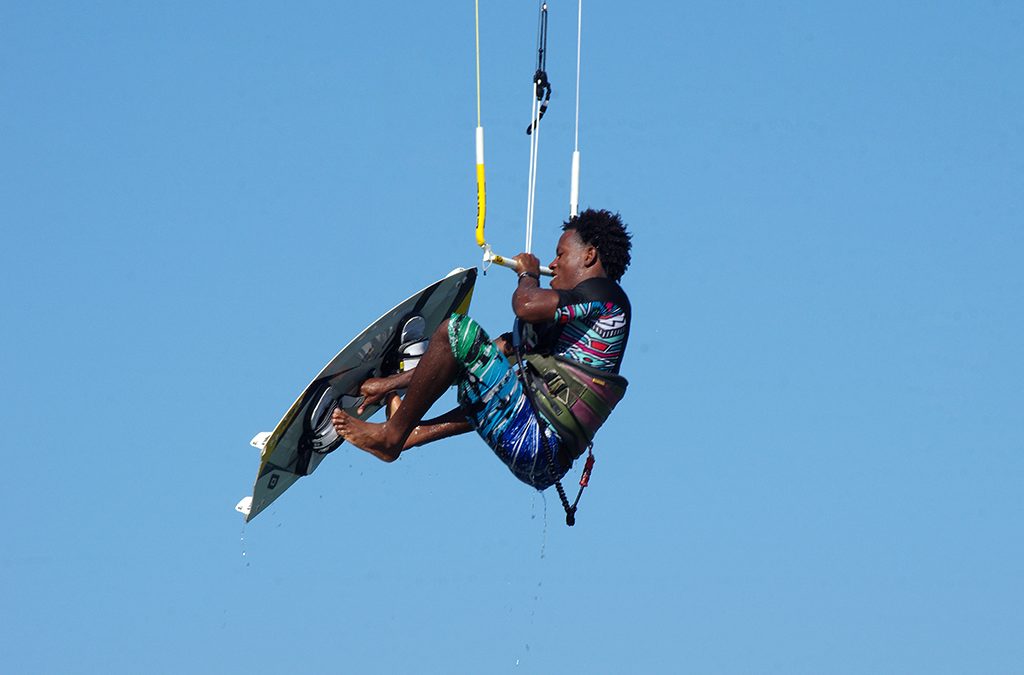Kitesurf or Kiteboarding is an action sport combining aspects of wakeboarding, snowboarding windsurfing, surfing, paragliding, skateboarding and sailing into one extreme sport. A kiteboarder harnesses the power of the wind with a large controllable power kite to be propelled across the water, land, or snow.
Kitesurfing is the world’s fastest growing extreme sport, and for good reason; it’s exhilarating, quick to learn and above all, really fun!
You need to learn with the right gear (a suitable kite, board and harness), at a suitable spot and with a qualified kiteboarding instructor.
How fit do I need to be to kitesurf?
You don’t need to be super-fit to kitesurf. You’ll often see little 10 year old kids out on the water. With the right kite nearly everyone can kitesurf. It’s not really your arms that take the strain – the pull of the kite goes through your harness, so it’s your core that gets the workout. Having said that, you need to be comfortable in the water and you do need a reasonable level of fitness.
How long does it take to learn how to kitesurf?
You can be up and riding with confidence in 3 days.
Kitesurfing is one of those rare sports that’s actually a lot easier than it looks. If you’ve flown a power kite and you’ve had a go at skateboarding, snowboarding or wakeboarding, you’re already more than halfway there. Typically, a 3-day, 4 hour per day course should see you up and riding with confidence. You’ll then need to get as much practice as possible to consolidate your skills and get comfortable riding up wind. The ability to ride upwind means you can stay out of trouble, avoid any hazards and get back to where you started.
Getting lessons from a qualified kitesurf instructor is undoubtedly the best way to progress quickly and safely.
Typically, a 3-day, 4 hour per day course should see you up and riding with confidence. An instructor will correct mistakes quickly and stop bad habits from forming.
Kitesurfing is an extreme sport and can be dangerous if it’s not given the respect it deserves. A 12 m kite accidentally pitched into the power zone can end in disaster. Even if you think you can learn on your own, teaching yourself will never replace the benefit of getting lessons. Plus, kite schools have access to loads of gear that will allow you to use a kite perfectly adapted to the spot and your skill level.
Be safe, have fun and get some lessons.
The following tips have been provided by Tantrum Kitesurf:
Extra Tip: Plan to learn somewhere that is similar to your local spot
Are you trying to choose between the hundreds of different schools and different locations all offering perfect wind, the best kit and super short training times. How can you possibly find the course that’s best for you?
Firstly, ask yourself the question, where are you going to be kitesurfing 90% of the time?
Of course all of us would love to be dashing of to remote, exotic locations with perfect wind and Pina Colada’s on tap every other week. The reality for most of us is somewhat different, and we find ourselves having to kitesurf wherever our nearest accessible bit of water happens to be.
Kitesurfing instruction on an International level is organised and controlled by the International Kitesurfing Organisation or IKO. Any school which is affiliated with the IKO has to have insurance and adhere to safety and teaching standards set down by the IKO.
The schools will most likely display their affiliation on their website or at least in their base of operations. If in doubt about a school or instructor you can check whether they are an official centre or official instructors on the IKO website, where all registered schools and instructors are listed for public viewing. Many countries now have a national level body as well, for example, the BKSA in the UK or the FFVL in France.
Kitesurf schools affiliated with these national bodies have to (in theory at least) meet equally strict standards as those to the IKO, so you can be sure they meet the latest standard for teaching methodology, insurance, and equipment. Of course, this doesn’t mean that schools operating without affiliation are fundamentally bad, many schools have very good reasons for not affiliating but it acts as a good guide to which schools are legitimate schools and which could more fly by night in nature.
Credits: https://www.ultimatefrance.com/kitesurfing/beginners-guide
